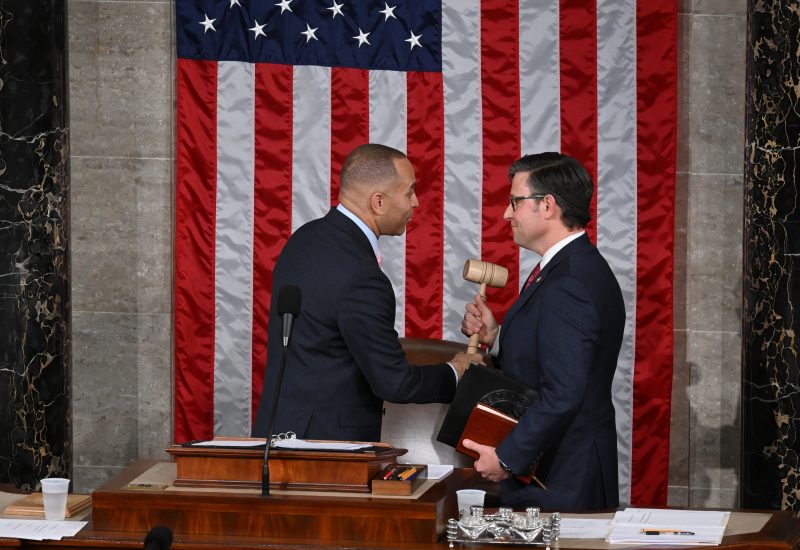Just eight minutes apart, the two political arms competing for the House majority blasted out memos claiming momentum citing the exact same analysis.
“Inside Elections shifts six races toward Democrats as momentum grows,” the Democratic Congressional Campaign Committee wrote a little past 4 p.m. Thursday.
“Inside Elections: House Republicans still the favorite,” the National Republican Congressional Committee boasted in its memo soon after.
That’s a sign of just how close the race for the House is: Each side found something tangible to praise in the latest report from the independent political analysis organization. The battle for the House is now fully resembling trench warfare, a political hand-to-hand combat.
The two most storied political analysis shops, Inside Elections with Nathan L. Gonzales and the Cook Political Report with Amy Walter, published reports that backed up Democratic claims of new momentum from Vice President Kamala Harris’s emergence in the presidential contest. Yet both give Republicans a decent chance of retaining the majority in the House.
Inside Elections noted that Republicans are “still slight favorites to hold the House” but estimated that the range of outcomes is a mere “Democratic gain of five seats to a Republican gain of five seats.”
The Cook Report delivered basically the same message. “We ultimately believe the most likely outcome is a single-digit gain for either party,” wrote Erin Covey, the organization’s House analyst.
That’s either enough to give Democrats the barest of margins, leaving them fearful of illnesses to determine their majority status on any given day, or enough to leave a narrow Republican majority staring down a group of 15 to 20 staunch conservatives who upended much of the GOP agenda over the past two years.
For obvious reasons, the presidential contest receives the vast majority of attention these days, while the battle for the also narrowly divided Senate gets a similar level of hype with so many of those battleground races overlapping with the key electoral college contests.
In the House, Democrats will go into the election with 214 seats (three of which are vacant but are in deep-blue territory) while Republicans hold 221 (one vacancy in deeply red terrain), an even narrower margin than the 222-213 Democrats held just ahead of the 2022 midterms.
With those estimates from the two independent analysts, the majority might once again fall below 225 seats, which would be another marker for how divided the times are.
In the 39 elections since the end of World War II, the majority has ended with at least 225 seats in all but five times, according to the House historical site. This era now resembles the late-1990s and early 2000s, when the GOP went four-straight elections winning a majority but with less than 230 seats.
Usually one party or the other tends to go on long, steady runs with sizable majorities that eventually collapse, and usually in a big fashion. House Republicans had an eight-year run of being in charge in the past decade, most of that time holding more than 240 seats. That was until the 2018 midterms delivered Democrats a gain of more than 40 seats for the majority.
Democrats controlled the House for 40 years last century in a run that ranged from holding between 232 seats and more than 290 — until the bottom fell out in 1994, when they lost 54 seats and the majority.
Yet the 2020 and 2022 elections have demonstrated the static nature of American politics.
Four years ago, House Democrats swung big, thinking they had strong tailwinds from the backlash to President Donald Trump and his handling of the coronavirus pandemic. But Democrats end up losing more than 10 seats despite President Joe Biden’s 7-million-ballot margin in the popular vote, clinging to a tiny majority, with just 222 seats.
Before the midterms two years ago, House Republicans declared that a “red wave” was at hand and targeted 75 Democratic districts, including 31 that Biden had won in 2020 by at least 10 percentage points.
They got the majority, barely, only because of a surprising GOP performance in New York and Los Angeles regions.
Having learned their lessons, the DCCC and NRCC have shrank their ambitions this election cycle and are targeting a much smaller share of the House’s 435 seats than they did in recent campaigns.
The “Red to Blue” program, for Democrats, officially lists fewer than 30 candidates running in districts held by Republicans. And the NRCC’s “Target List” tops out at 40 seats held by Democrats, many of which are receiving not much financial support.
As the political analysts note, the true battlefield might include fewer than 35 seats.
“The race for the House remains incredibly close. The battleground is confined to a few dozen seats across the country where neither party appears to have a clear advantage,” Covey wrote.
Each side starts off with the likely claim to three seats from the other party as a result of mid-decade redistricting that happened in Alabama, Louisiana, New York and North Carolina.
Inside Elections rates seven seats held by Democrats as pure toss-ups, while five Republican seats have that ranking. Another six Democratic seats have a “tilt” rating toward staying in that column, while 10 GOP seats “tilt” toward them.
The Cook Report’s slightly different rating places 11 Democratic seats and 13 GOP seats in the pure toss-up category.
Some races will probably change in the final seven weeks of campaigning, either becoming newly competitive or losing steam as one candidate races ahead. For now, there are less than 30 total seats truly competitive.
A Democratic victory would be the third time in four elections that the House majority changed hands, an era of instability only rivaled by the immediate postwar era in which the majority switched four times in the five elections from 1946 to 1954.
Harris’s strong campaign has boosted chances for Democrats and, while they need to win more of the toss-up races, they now have the better chance to expand races into GOP territory and multiple paths to the 218 seats needed for the majority.
“If Harris continues to perform well at the top of the ticket, that will improve her party’s chances in the House because of the lack of ticket splitting,” Gonzales and Jacob Rubashkin wrote in Inside Elections.
The Cook Report’s ratings give Republicans a likely floor of 208 seats, with Democrats’ worst-case outcome being 203 seats, and the remaining 24 deciding the majority.
Citing private polling shared with their analysts, Republicans were on track to hold and probably expand their majority before Biden bowed out of the election on July 21.
“District-level polling looked dismal for Biden,” Covey wrote. “Trump was carrying districts that Biden won by several points.”
As is the case in the presidential and Senate races, House GOP candidates have a money problem. Their incumbents running in competitive races had a median cash on hand of $2.3 million, compared to $1.8 million for their Democratic challengers as of June 30.
But, according to Covey, Democratic incumbents held a nearly $4-to-$1 advantage over GOP challengers. That advantage will allow Democrats to focus more of their financial resources on offense and force Republicans to play more defense.
And not all toss-up races are created politically equal.
Of the 11 toss-ups Democrats are defending, seven of those districts favored Biden over Trump four years ago, with Trump narrowly winning in three others.
Of the 13 toss-ups Republicans are defending, six favored Biden by at least 10 points four years ago, with three more giving him a margin of victory between 5 and 10 points.
Trump needs to shore up his standing in the next few weeks following his shaky debate performance Tuesday, while Harris could provide more energy and help Democrats.
Regardless of which side wins, its majority is all but certain to be small and difficult to manage next year.





























